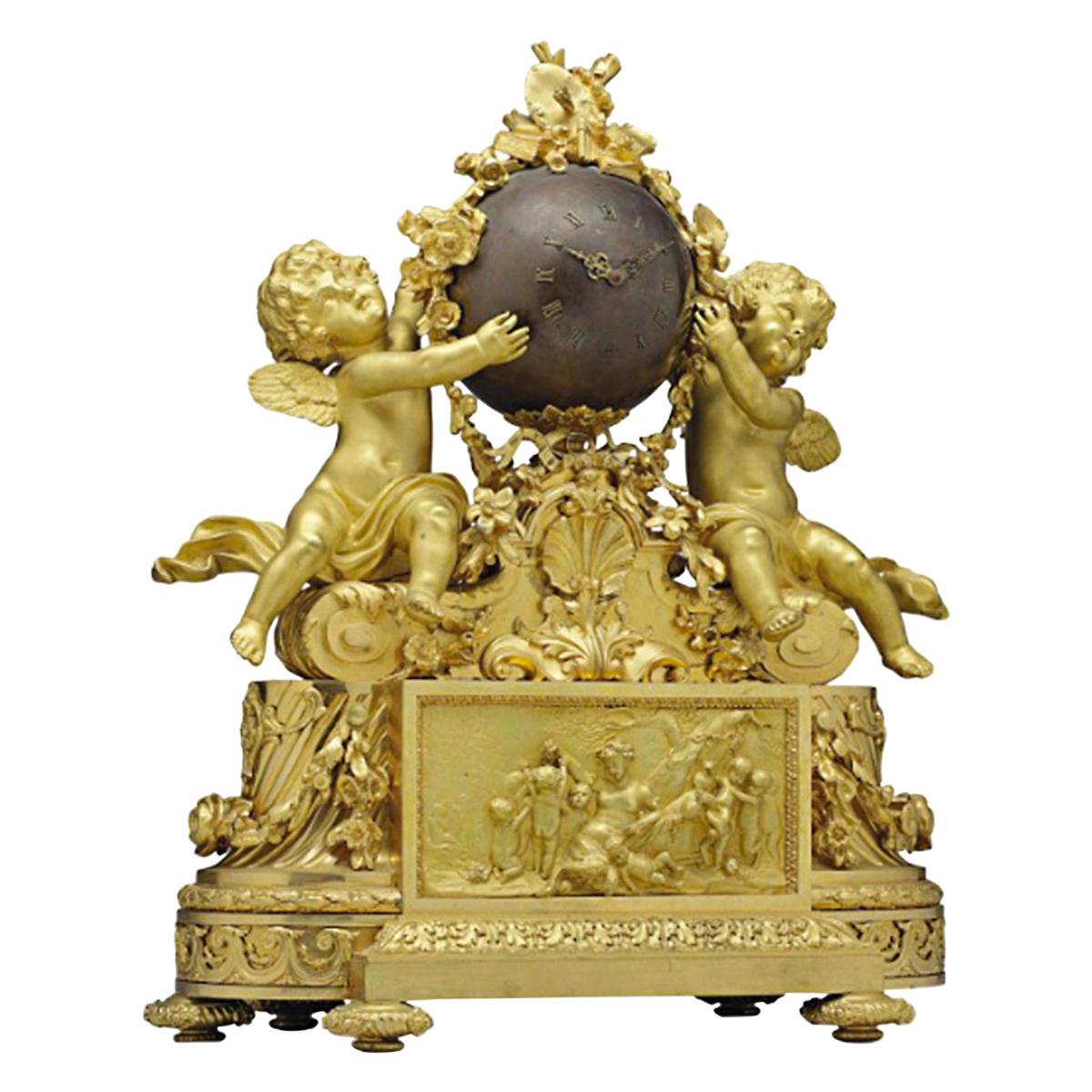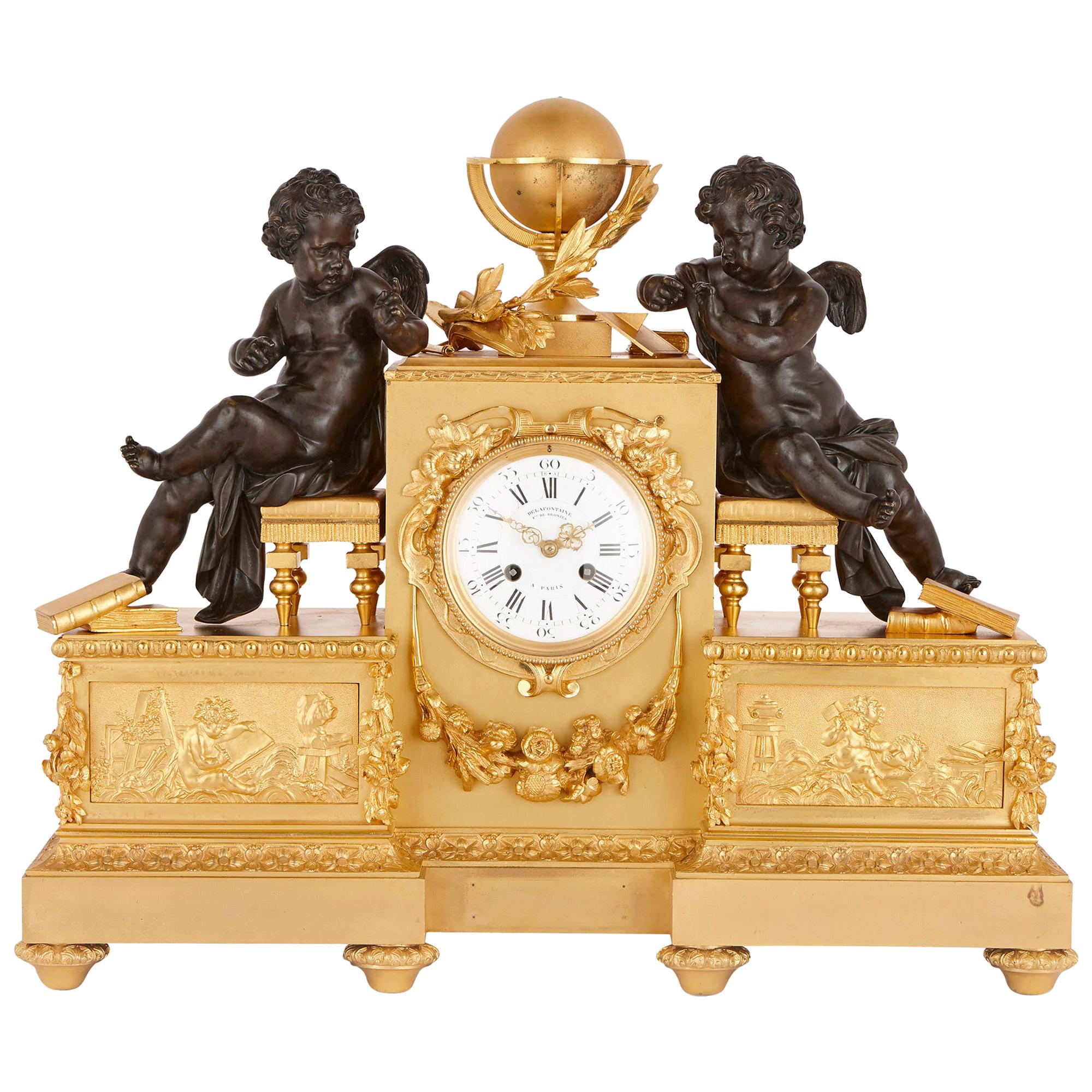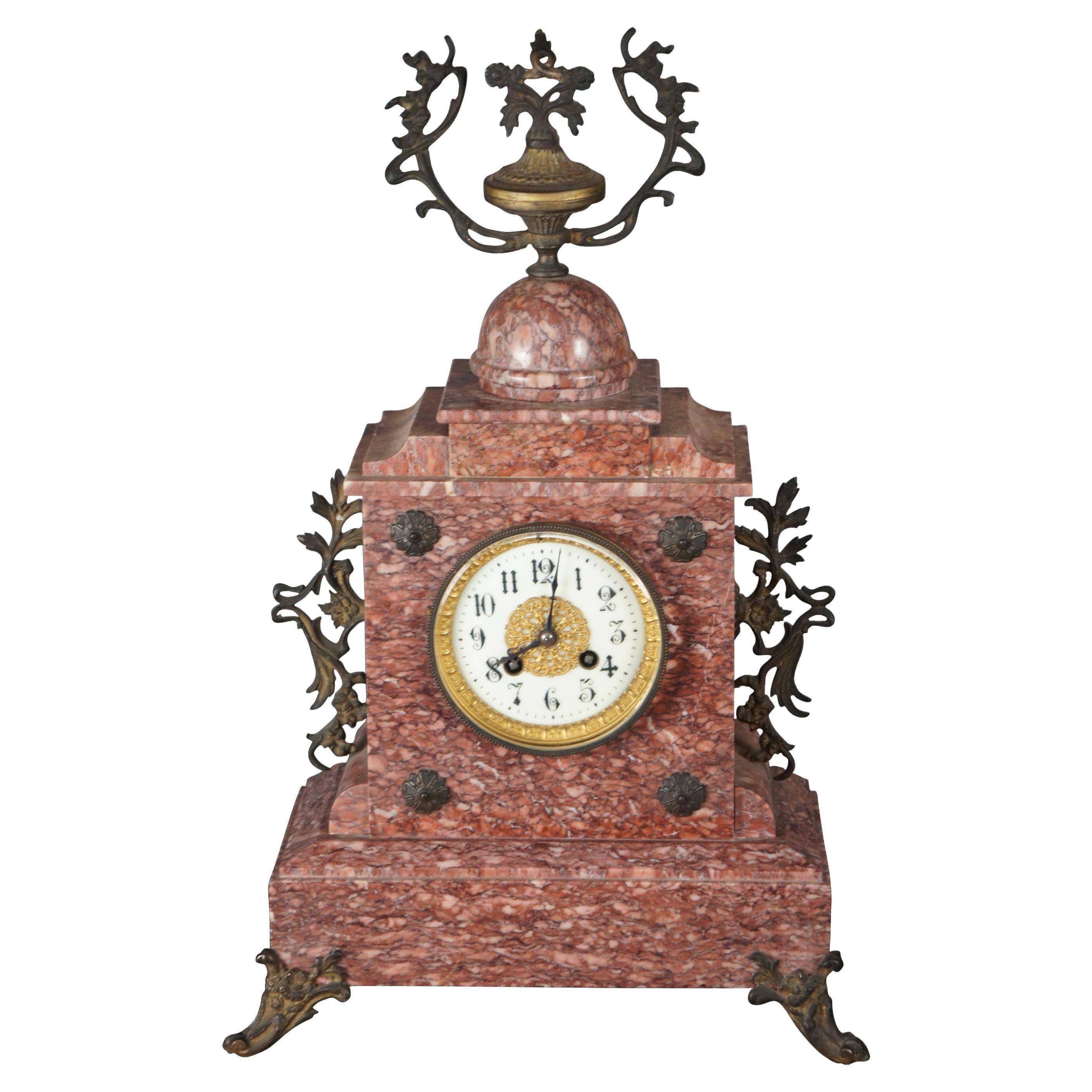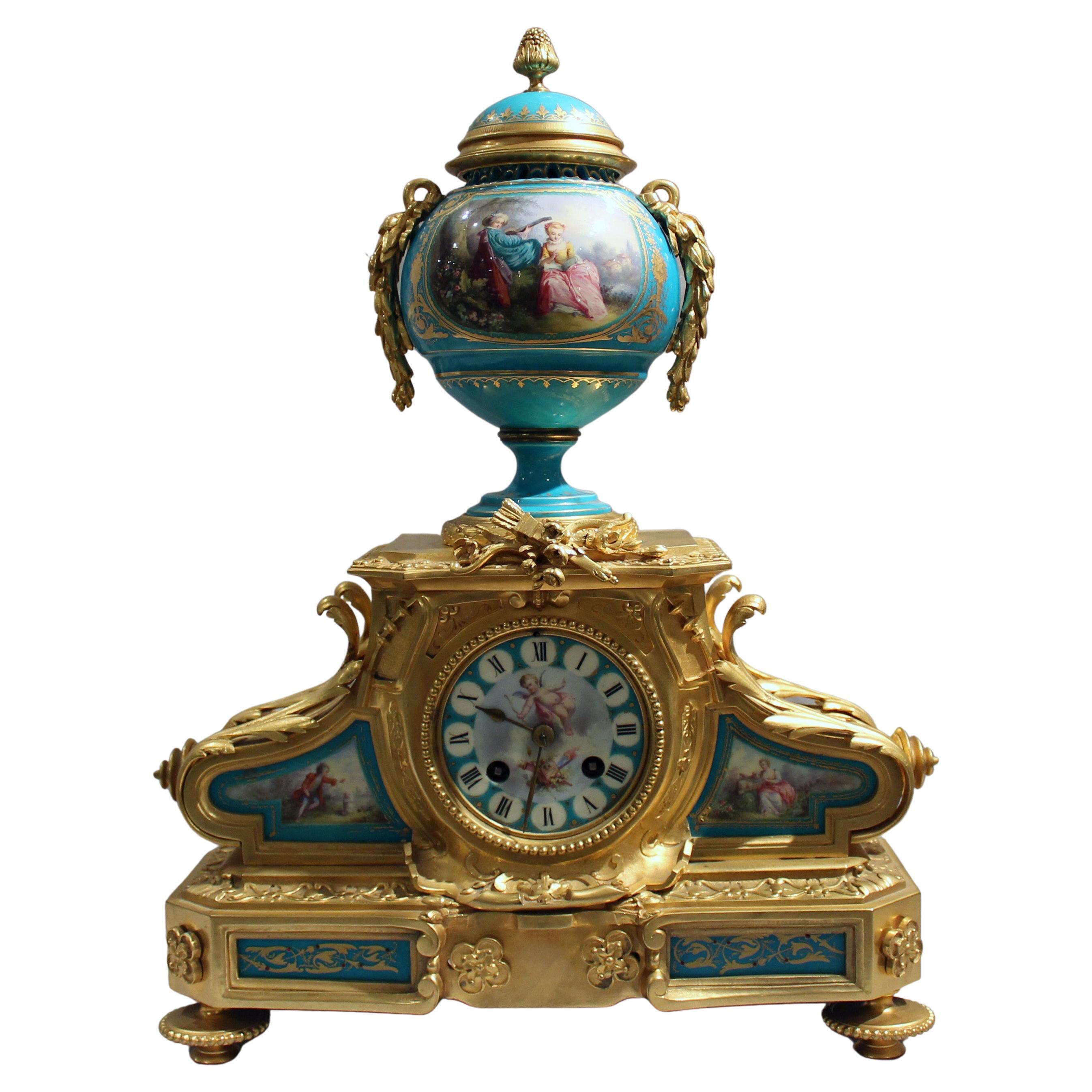Items Similar to Palatial & Rare Napoleon III French Ormolu and Patinated Bronze Clock, Detouche
Want more images or videos?
Request additional images or videos from the seller
1 of 21
Palatial & Rare Napoleon III French Ormolu and Patinated Bronze Clock, Detouche
About the Item
A palatial, extremely rare, and important Napoleon III French ormolu and patinated bronze regulateur de parquet clock, by Louis-Constantin Detouche, Paris, circa 1850.
The clock case made form the finest French ormolu, with 2 very large patinated bronze seated putti
The white enamel dial Signed C. DETOUCHE/ PARIS. The clock movement is numbered 7064 and stamped with maker’s stamps C. Detouche RUE st. MARTIN and C. DETOUCHE 158 R. St MARTIN 160, with medaille d’argent stamp, on a serpentine part ebonized mahogany plinth.
At over six feet tall, the present clock is impressive in scale and rare in Detouche’s oeuvre. While other large clocks were produced by the firm, few of this scale are so overtly decorative and usually incorporate greater mechanical complication. For example, a gilt bronze astronomical regulator clock of 185 cm height, dating from circa 1855-1860 and with a very similar pendulum to the present example, that sold ArtCurial, Paris, 11th December 2007 ($218,625 including premium), and a tall mahogany-cased electric regulator clock of the same date from the Paul Garnier collection that sold Christie’s London, September 15th 2004 ($86,909 including premium). Another comparable large case clock, dating from 1863, one of several donated by Detouche to the Conservatoire Impérial des Arts et Métiers de Paris (Musée des Arts et Métiers inv. 07179-0000), appears to be currently disassembled.
The present clock corresponds to a description given by a critic commenting on the Detouche exhibit at the Nimes exhibition of 1862, who remarked:
“M. Detouche has already received the most prestigious awards; I will just mention: the gold medal at the Exposition Universelle d'Horlogerie at Besançon in 1860, and the gold medal in London in 1862. He was awarded La Croix de la Légion d'Honneur for his contribution toward the progress in horology that resulted from his work, the Croix de Dannebrog was awarded to him by the King of Denmark for his electric clock. Such items deserve to be described in a few details. They present improvements worthy to be known and appreciated by every clockmaker who has benefited from M. Detouche's work and true service… The jury noted secondly a rocaille style regulator in gilt bronze of a remarkable taste, measuring 1m, 90… All of the items shown by this company are to be noted for their modest prices, their elegance, their rich ornamentation and precision, and their skilled workmanship. The jury awards to M. Detouche a diplôme d'honneur." [translated from the French, op. cit.]
Louis Constantin Detouche, the son of Parisian clockmaker Georges Detouche, was born in Paris in 1810. In 1830 he moved his father’s business from rue de Venise to 158-160 rue St. Martin. In 1845, Detouche employed as his chef d’atelier Jacques François Houdin, whose technical virtuosity and invention did much to establish the firm’s reputation, garnering them praise for their ingenuity, patents and highly sophisticated precision movements, compensating pendulums, astronomical complications, and use of electro-mechanical movements. The Maison Detouche, exhibited at the Great Exhibition of 1851, and many subsequent International and regional exhibitions to much acclaim, winning gold medals at the Exposition Universelle Paris 1855, Besançon 1860, London 1862 and Nimes 1862. Awarded the Danish Croix de l'ordre du Dannebrog, and the French Légion d’honneur in 1853 for his contribution toward the progress in horology that resulted from his work, Detouche was also the official clockmaker to the city of Paris and the Emperor Napoleon III.
Among Detouche’s most celebrated works is one of two spectacular astronomical regulators with fourteen subsidiary dials showing indications of the days, months and dates, sunrise and sunset time, the equation of time, moonrise and moonset, lunar phases, barometer and thermometer, and the time in several cities, which once stood at the corner of the rue Saint-Martin and the rue de Rivoli but is now housed in the showroom of François-Paul Journe SA Manufacture in Geneva.
Provenance:
Exhibited at the Great London Exhibition 1851
Exhibited by Detouche at the Exposition de Nimes, 1862, where Detouche won a gold medal, the clock remarked by the jury as “un régulateur genre rocaille en bronze doré, d'un gout remarquable et d'une hauteur de 1m 90”.
By repute, formerly in the collection of the Florsheim family, Chicago
Private North American collection, acquired privately early 2000s
Literature:
Revue Chronométrique, vol. IV, Paris, 1862, "Exposition de Nîmes - Rapport du Jury” pp. 605-609.
Tardy, Dictionnaire des horlogers français, Paris, 1971-1972, pp. 182-183.
Measures: 81" high x 50" wide x 19" deep
Excellent condition. No damages noted.
The glass panels on the front and back of the lower sections have been replaced by Perspex.
- Creator:C. Detouche (Clockmaker)
- Dimensions:Height: 81 in (205.74 cm)Width: 50 in (127 cm)Depth: 19 in (48.26 cm)
- Style:Napoleon III (Of the Period)
- Materials and Techniques:
- Place of Origin:
- Period:
- Date of Manufacture:circa 1860
- Condition:Wear consistent with age and use.
- Seller Location:New York, NY
- Reference Number:1stDibs: LU1798215584552
About the Seller
5.0
Vetted Seller
These experienced sellers undergo a comprehensive evaluation by our team of in-house experts.
Established in 1980
1stDibs seller since 2016
58 sales on 1stDibs
Typical response time: <1 hour
- ShippingRetrieving quote...Ships From: New York, NY
- Return PolicyA return for this item may be initiated within 7 days of delivery.
More From This SellerView All
- Pair of French Ormolu and Patinated Bronze Figural Busts on Porphyry BasesLocated in New York, NYA Pair of French Ormolu and Patinated Bronze Figural Busts on Porphyry Bases, circa 1875. One bust signed Marin, the other L.V.E Robert - a truly magnificent pair of busts...Category
Antique 19th Century French Napoleon III Figurative Sculptures
MaterialsPorphyry, Bronze, Ormolu
- Edward F. Caldwell, An Extremely Fine and Rare Ormolu-Mounted Malachite ClockBy Edward F. Caldwell & Co.Located in New York, NYEdward F. Caldwell and Co., An extremely fine and rare American ormolu-mounted malachite clock with the prince of wales's feathers, circa early 20th century The shape, design, and...Category
Early 20th Century American Mantel Clocks
MaterialsMalachite, Bronze, Ormolu
- Unusual French Ormolu and Jeweled Clock Made for the Ottoman Turkish MarketLocated in New York, NYAn Unusual French Louis Philippe Ormolu and Jeweled Clock Made for the Ottoman Turkish Market, circa 1840. The scrollwork case suspending a ribbon-tie...Category
Antique 19th Century French Islamic Mantel Clocks
MaterialsBronze, Ormolu
- Exceptional White Marble Figural Sculpture Clock, "Nubian Slaying the Lion"Located in New York, NYAn exceptional and monumental white marble figural sculpture clock, "A Nubian Slaying The Lion" by Jean-Joseph Jacquet (Belgian, 1822–1898), c...Category
Antique 19th Century Belgian Figurative Sculptures
MaterialsMarble
- An Exquisite and Rare French Louis XVI Style Ormolu-Mounted Bloodstone InkwellLocated in New York, NYAn Exquisite and Rare French Louis XVI Style Ormolu-Mounted Bloodstone Inkwell, circa 1875. A truly exceptional and jewel like quality inkwell encrier, made with the finest ormolu, mounted on bloodstone. A true collectors and one of a kind piece. Revival of the ancient régime in the late 19th century was paramount to the French furniture and bronze casting firms of the Belle Epoque. Imitation in the highest regard and replication of those tastes and styles was prevalent throughout the Paris Faubourg, where the most talented bronziers and ébénistes established their workshops. The present inkwell encrier recalls the late 18th century's obsession with hardstones - a taste expounded above all by the duc d'Aumont and, subsequently Marie-Antoinette. Such hardstone-mounted pieces, reminiscent of Renaissance schatzkammer objects, enjoyed a revived popularity at the end of the 18th century through the impetus of both the marchands-mercier and, more importantly, the hôtel des Menus-Plaisirs, where the duc d'Aumont himself established a workshop in 1770 specializing in the cutting and polishing of precious hardstones. This exceptional inkwell encrier, sumptuously-mounted with finely chased gilt-bronzes, incorporates a highly-prized material such as bloodstone. Sometimes called the Sunstone, the meaning of Bloodstone comes entangled in fascinating history. The Ancient Greeks held the Bloodstone as a gem with glorious powers. They referred to it as Heliotrope, which directly translates to Sunstone. It was believed to have heavenly healing powers gifted by the gods and most certainly when it came to healing all things related to the blood. Even as we move forward into the Middle Ages, the Bloodstone takes another mystical story under its wing. It was believed to be formed from Christ's blood. It was said that during the Crucifixion, a few red spots of his blood dripped...Category
Antique 19th Century French Napoleon III Inkwells
MaterialsBronze, Ormolu
- Monumental French Patinated Bronze Bust of William Shakespeare, After HoudonBy F. Barbedienne FoundryLocated in New York, NYA monumental French patinated bronze bust of William Shakespeare, after Houdon, by F. Barbedienne Foundry, circa 1870. Masterfully and realistically sculpted in solid bronze, this...Category
Antique 19th Century French Napoleon III Busts
MaterialsBronze
You May Also Like
- Napoleon III Ormolu and Patinated Bronze Figural Mantel ClockLocated in New York, NYWith two putti flanking the bronze spherical clockface, topped by a garlanded trophy, the movement stamped BR DENIERE A PARIS/2197 Maker: Jean-François D...Category
Antique 19th Century French Mantel Clocks
MaterialsBronze
- Napoleon III Period Ormolu and Patinated Bronze Clock Set by PicardBy Henri PicardLocated in London, GBThis magnificent clock set is the work of celebrated French maker Henri Picard, who collaborated on this fine piece together with the famous firm of clockmakers, Raingo Freres. Both ...Category
Antique 19th Century French Neoclassical Mantel Clocks
MaterialsOrmolu, Bronze
- Napoleon III Period Gilt Bronze and Sèvres Style Porcelain Mantel ClockBy Miroy FrèresLocated in London, GBThis sophisticated gilt bronze mantel clock is an elegant piece of mid-19th century design, beautifully cast and gilded and set with two delicate Sèvres style porcelain panels. The clock case's finest feature is the charmingly naturalistic scene at its top, showing a full-length sculpture of a female figure sitting with a basket and two doves. They are displayed on a naturalistic, oval-shaped plinth, which is decorated all around its exterior with painstakingly intricate foliate motifs. Either side of the plinth there are two Sevres style porcelain panels, each of which shows a winged putto. One putto is shown writing, while the other is shown holding a dove. Each is set inside a turquoise blue border decorated with delicate gilt scrolls. In the centre of the plinth sits the clock dial, which is enamelled and contains Roman numerals. It is signed 'Prize Medal 1851 / Miroy Fres Brevetes / Paris' after the clock's maker, Miroy Freres...Category
Antique 19th Century French Napoleon III Mantel Clocks
MaterialsOrmolu, Bronze
- Napoleon III Period Gilt and Patinated Bronze Clock by DelafontaineLocated in London, GBThe acclaimed French bronze foundry, Delafontaine, created this remarkable mantel clock. At the time this piece was crafted, in c.1860, the company was directed by Auguste-Maximilien Delafontaine (1813-1892). The firm was famous for its high-quality artistic bronzes, which can today be viewed in major art collections, such as the Louvre in Paris. Shaped like an upside down ‘T’, this gilt bronze...Category
Antique 1860s French Napoleon III Mantel Clocks
MaterialsBronze, Enamel, Ormolu
- Antique French Napoleon III French Rouge Marble & Bronze Ormolu Mantel Clock 20"Located in Dayton, OHAn antique 19th Century mantel Clock. Made from Rouge marble with bronze ormolu. Ornately designed with gold filigree face, a stepped base, footed over downswept legs. Features ornat...Category
Antique 19th Century Napoleon III Mantel Clocks
MaterialsMarble, Bronze
- French Napoleon III blue porcelain and ormolu clockLocated in London, GBA very fine & attractive French porcelain & gilt bronze mantle clock. A superb dial & very finely painted urn surmounting the clock. To each side of the dial further painted panels. ...Category
Antique 1880s French Mantel Clocks
MaterialsBronze
Recently Viewed
View AllMore Ways To Browse
Medal And Bronze
Medal Exposition
Napoleon Signed
19th C French Object
French Ormolu Bronze Clock
Rocaille Style
Napoleon Ormolu
Rare Antique Clock
Rare Antique Clocks
R And Company
Exhibition 1862
1851 London Exhibition
Napoleon Iii Ormolu
Antique Clockmakers
Napoleon Seat
Napoleon Iii Enamel
Napoleon Clocks Antique
Antique Napoleon Clock





